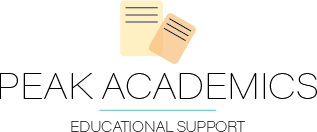Beyond hard work and content mastery, successfully navigating the academic world requires a robust set of cognitive skills known as executive functions (EFs). This umbrella term includes multiple complex thinking processes that allow us to regulate behavior, set and meet goals, and actively manage each stage of task completion.
For students of any age, strengthening these skills is foundational to academic success: strong time management, organizational systems, and self-awareness play a critical role in the learning process and task completion. They are also key to increasing independence and reducing stress. By employing simple, consistent strategies at home, parents and caregivers can significantly support the development of these critical life skills.
STRATEGY #1: EXTERNALIZE AND VISUALIZE TIME
Teaching effective time management begins with making the abstract concept of time more concrete and visible in a child’s daily life. Students often struggle with accurately predicting how long a task will take or how much time they have available to complete the steps involved. Establishing routines and using visual tools can help bridge this gap.
Building a Routine: Use a physical planner or a whiteboard to map out daily and weekly schedules, including academic work, extracurricular activities, and downtime. This externalizes the schedule, making it a clearly communicated reference point.
Employ Time-Tracking Tools: For specific tasks, try using a visual timer (such as a sand or kitchen timer) instead of a phone. Seeing the time literally "run out" can improve focus and self-monitoring. To further enhance this aspect of time management, ask your child to estimate how long it should take to complete an assignment, then set the timer for that long. Over time, they will better understand how to accurately predict these windows, which in turn supports their ability to plan/prioritize, initiate a task, and sustain attention.
STRATEGY #2: ORGANIZE THE ENVIRONMENT AND THE MIND
The science on clutter is clear: a disorganized physical space negatively impacts learning and focus, and it often reflects a disorganized approach to tasks. Establishing a structured system for materials and information reduces cognitive load, making it easier for students to start, execute, and complete work.
Designated Workspace: Create a dedicated, consistent location for essential items, such as a homework station, a charging spot for electronics, and specific folders or binders for each subject. Knowing where to find and put back materials minimizes distractions and time wasted searching. In addition, having a binder system can play a critical role in supporting long-term academic success.
Backward Planning Technique: The overwhelm of a large, multi-step project can trigger procrastination and avoidance. According to a 2018 study on backward planning (scheduling steps in reverse order from a due date to the present), taking this approach “not only led to greater motivation, higher goal expectancy, and less time pressure but also resulted in better goal-relevant performance.” Try working together with your child to identify the deadline, then break the project into smaller, manageable subtasks with their own, earlier deadlines. For example, the first step for a research paper is selecting the topic; the second is creating an outline; the third is drafting a section. This sequential approach to organization strengthens planning and prioritization skills.
STRATEGY #3: FOSTER SELF-MONITORING AND FLEXIBILITY
Rather than acting as a static, fixed point, executive functions require constant reassessment and adjustment, also known as self-monitoring or metacognition. Students must become active participants in their own learning process: setting and tracking progress towards goals, actively monitoring their focus and understanding, and flexibly responding to challenges.
Use Checklists for Focus and Completion: To-do lists serve a dual purpose: they guide children through the steps of a task and provide a rewarding visual record of their achievements. It can also help to incorporate steps such as "Check Work for Errors" and "Put Materials Away," which reinforces thoroughness and organizational behaviors.
Practice Problem-Solving Scenarios: When a study plan fails or a task proves more challenging than expected, resist the urge to immediately solve the problem. Instead, ask your child to identify what the obstacle is and brainstorm different approaches they could take. This gentle questioning encourages cognitive flexibility and self-correction, teaching them how to adapt new strategies when they encounter unexpected challenges. Challenges naturally increase in complexity as they get older, so supporting the development of these skills also helps build the self-esteem and self-efficacy they will need to confidently evolve with them.
When a child’s home environment provides a solid framework for managing their academic responsibilities and prioritizes strategies that cultivate the development of executive functioning skills, the benefits are made manifest in every area of their lives. These skills are universally relevant: they transfer from the desk to the classroom and eventually to the demands of adult life, setting the stage for long-term success and independence.
Written by Brandi R.




















